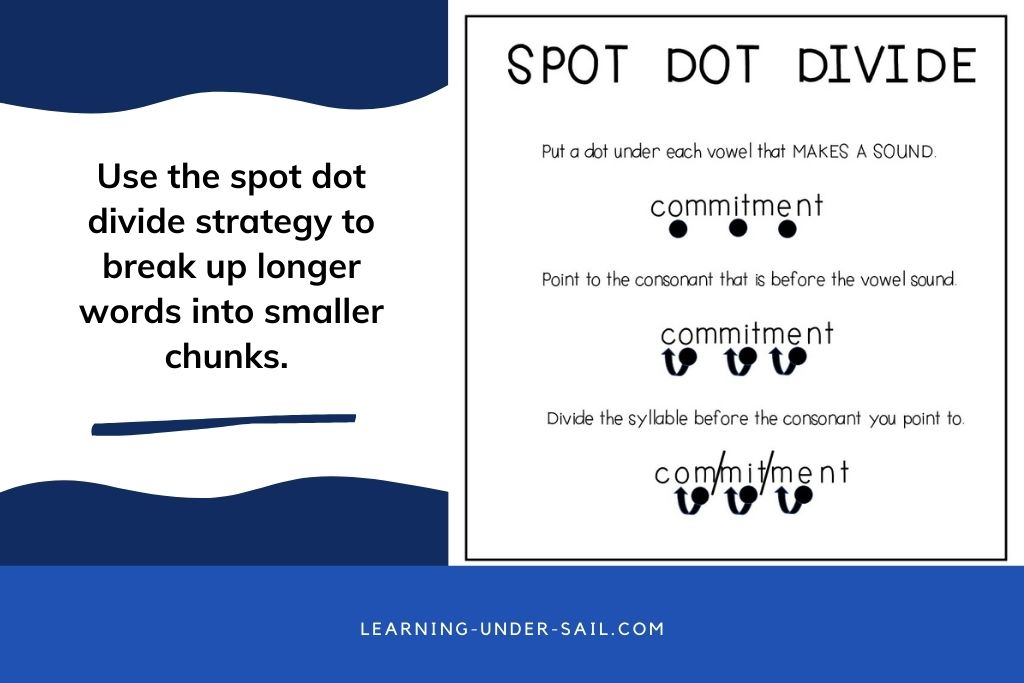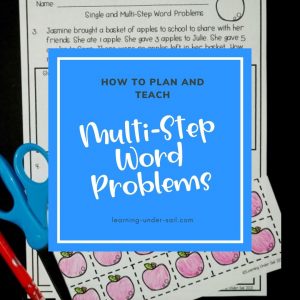Why should you teach upper elementary students how to decode words? Isn’t that a skill they learn in first grade? Maybe. Many upper elementary students need a strategy to decode longer multisyllabic they encounter as they read at higher levels.
Do have upper elementary students who seem to be “stuck” in reading? Have you noticed that they just skip longer words? They need a strategy for how to decode longer words.

One year I was struggling to make reading progress with my third graders. After a discussion with my reading specialist, I realized I was only focusing on comprehension, not decoding. The reading specialist suggested I focus on teaching syllables to take my kids to the next level. She asked how I teach syllables. I explained that we clap out syllables or put our hand under our chin to count the syllables as we say the word. This is not what she had in mind. She brought me some materials and I realized that we really needed a strategy to understand syllables in longer words. I wasn’t teaching how to break up and decode multisyllabic words. Syllable instruction was a game changer for this class.
The main strategy I use to teach how to decode words is the spot dot divide strategy. It is a systematic way to break longer words into chunks, read the chunks, then blend the chunks together. It doesn’t work perfectly every time because there are so many exceptions to rules in English, but it does give students a strategy for breaking up words into smaller chunks.
Why I love using the spot dot divide strategy to teach how to decode words:
- It gives students a strategy to figure out longer words.
- It trains students to look for small chunks and patterns in words, so they begin to recognize word patterns without using the strategy.
- Even if the strategy is not done perfectly, students can usually break up the word enough to figure out what it says.
After using this strategy for a couple of months, my students’ reading scores took off.
I’ve used this strategy for quite a few years. It’s perfect for intervention groups or the whole class. First, start with the basics of defining vowels, consonants, and syllables. Next, teach or review short vowels, blends, and diagraphs. Then, teach or reteach the magic e rule. After that, add in other syllables as needed. Once you teach the spot dot divide strategy, you don’t need to work your way through all the different types of syllables, just the syllables that your students need.
Free resources that I use to teach syllables:
Syllable Division Rules Foldable
Printable Spot Dot Divide Rules
7 Syllable Types Classroom Posters

Step 1 – Review the definition of vowels and consonants
This sounds pretty basic, but in my experience, most of my students can’t tell me what a consonant is. It is important to define vowels and consonants before teaching the spot dot divide strategy. I have even given students a strip of paper with the vowels listed on it for reference.
Explain that each syllable has a vowel (possibly a vowel sound made with y). This is also a great time to review the definition of a syllable. I keep the definition simple: a unit of a word with a vowel sound.
Step 2 – Review the sound of short vowels
Next, review the sound of short vowels and the pattern that they follow (CVC – Consonant Vowel Consonant). These will be the first syllables that we look for. Some example words that can be used to illustrate the CVC syllable pattern are: sunhat, hotdog, and catnip.
Step 3 – Teach spot dot divide strategy
In step 3, show the spot dot divide directions from LambReads and model how to use the strategy. Then, hand out the little direction squares and have students practice with you. Here are some multisyllabic words with only short vowels: hazmat, success, and commitment.

Step 4 – Review consonant blends and diagraphs
When using the spot dot divide strategy, consonant blends and diagraphs (sh, th, wh, ph, wr, ck) stay together. In step 4 we learn this rule and practice using it. Here are a few words to practice with: whisper, citizenship, and photograph.
Step 5 – Review the magic e rule
A tricky part of the spot dot divide strategy is that students need to dot the vowels that make a sound. I always do a quick review of the magic e rule and then practice dividing multisyllabic words with a silent e into chunks. Here are a few words to practice with: organize, envelope, calculate, performance, intelligence, demonstrate.
Step 6 – Review vowel teams and diphthongs
Students also need to be aware that when two vowels are next to each other, only one of the vowels makes a sound. I like to use the 7 Syllable Type Classroom Posters from Make Take Teach to review the different vowel teams and diphthongs. Then, the group practices using the spot dot divide strategy with words like entertainment, appointment, mountain, chimpanzee, and neighborhood.
Step 7- Other syllable types
Finally, I use the 7 Syllable Type Classroom Posters to teach the consonant-le syllable. Then I use the syllable division rules foldable from inspired literacy to review what we have learned and teach that prefixes and suffixes are often one syllable.
It usually takes about a week of mini-lessons to teach the spot dot divide strategy. Then the challenge is to get students to slow down and start using it! To encourage students to use the strategy as they are independently reading, I hand out Post-It notes and ask them to bring one tricky word with them to the group every time we meet. When the student brings the word, the group will use spot dot divide to divide the word into syllables and decode the word.
I use the words that the students bring to the group as a formative assessment to see if they need further phonics instruction.
Use this strategy regularly and your students will become more fluent decoding and reading multisyllabic words, just like they did when they were first learning to read shorter words.
Related Articles:
Syllabication Method: Spot Dot Divide (Downloadable Lesson Plan)
Designing Interventions: The Chicken or the Egg
The Big 5: Phonics – Teaching Syllabication
Motivating Reluctant Learners to Work Independently in Upper Elementary – 8 Strategies to Use Today
Need some FREE resources to teach prefixes, suffixes, synonyms, antonyms, and homophones? Check out this article:
How to Use Your FREE Vocabulary Intervention Plans and Activities
What’s your biggest intervention challenge? I’d love to know! Leave me a message in the comments.










